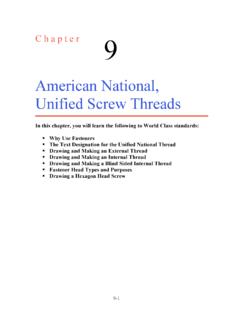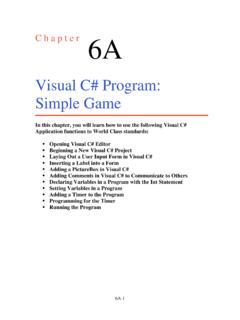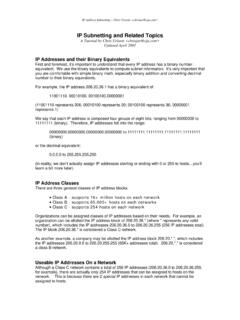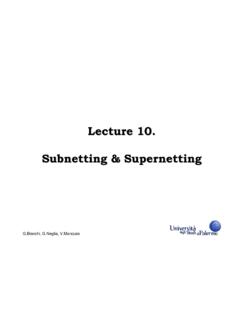Transcription of Visual Basic Program: Subnetting Calculator
1 C h a p t e r 7 Visual Basic Program: Subnetting Calculator In this chapter, you will learn how to use the following Visual Basic Application functions to World Class standards: Opening Visual Basic Editor Beginning a New Visual Basic Project Laying Out a User Input Form in Visual Basic Insert a Label into a Form Insert a Textbox into a Form Insert a Label into a Form to Post an Output Insert Command Buttons into a Form Adding a Copyright Statement to a Form Adding Comments in Visual Basic to Communicate the Copyright Declaring Variables in a Program with the Dimension Statement Setting Variables in a Program Using Condition Statements Writing Information to a Text File Resetting the Data Exiting the Program Adding a Browse and Open File Button Running the Program 7-1 Subnetting a TCP/IP Network _____ Many times when we write a new program.
2 We will want to output the data to a computer file such as a text document, spreadsheet or database. The Subnetting Calculator application in this chapter is a perfect example of a computer program that can create as few subnets as two or as many as 256, so we choose to send the IP addresses to a text file. In this lesson, we need to utilize textboxes, labels and command buttons as we have in previous training sessions, but we will create an additional two command buttons to browse for the folder to place the newly created text file and another push button to open the computer file after we calculate the values of each subnet . In our tutorial, we again use condition statements to make decisions, we utilize while loops to repeat repetitive expressions and we continue to concatenate strings to construct information that is useful to the computer user.
3 Although this program is larger than some done before, many components of the code are rhythmic and we can quickly spot the changes to each segment of the software. Open the Visual Basic Editor _____ In this session, we will step through each procedure in adding labels, textboxes and command buttons and we will integrate into the tutorial the methods to add, subtract, multiply and divide numbers. We will also include formatting the answers as they are shown in the answer labels. As in every project, we will create variable, set their values, execute mathematical equations and output data. In this lesson, we revisit the procedure to add the computer date and time to the form.
4 Figure The Start Page To open a new project, we select File on the Menu Bar and New Project. We start a new Windows Application by picking the Windows Application icon from the installed templates list on the New Project window. 7-2 Figure New Project With the Visual Basic Editor open, select File on the Menu Bar and select Save All. For the location, we will browse to the folder Visual Basic Projects that we made in Chapter 2. We will name this project Subnetting Calculator . A folder called Subnetting Calculator will be made and all the files for the program will be located in the folder. Beginning a New Visual Basic Application _____ Remember, that all programming projects begin with one or more sketches.
5 The sketch will show labels, textboxes, and command buttons. In this project, we will name the input form, Subnetting Calculator . We will have six textboxes to key in the network IP address, the number of subnet and the filename that will hold the calculated data. We will have two labels with borders to output the subnet mask and the number of devices on each subnet . There will be labels to identify the textboxes and labels withy borders. We will have five command buttons, Browse, calculate , Open File, Reset and Exit. On the bottom of the form, we will write the copyright statement using another label. On this presentation, we can help ourselves by being as accurate as possible, by displaying sizes, fonts, colors and any other specific details which will enable us to quickly create the form.
6 On this form, we will use a 12 point Arial font. From the beginning of inserting the form into the project, we need to refer to our sketch. 7-3We should train new programmers initially in the art of form building. When using the editor, we insert and size the form, and selecting the Controls Toolbox, we will place all the various input tools and properly label them. Whenever we place an input tool, the properties window will display a list of every attribute associated with the tool, and we will take every effort to arrange the tool by performing such actions as naming, labeling and sizing the Visual input device. Figure Sketch of the Resistor Sizing Form Figure Designing the Subnetting Calculator Form in Visual Basic 7-4 Laying Out a User Input Form in Visual Basic _____ We will change the Text in the Properties pane to Subnetting Calculator to agree with the sketch in Figure Go ahead and change the form in two other aspects, BackColor and Size.
7 Alphabetic (Name) frmSubnettingCalc Size 446, 337 Text Subnetting Calculator The first number is the width and the second number is the height. The form will change in shape to the size measurement. Figure Setting the Form Properties The background color will change to a white. There are many more attributes in the Properties pane that we will use on future projects. In this project, we will select the font in the form. By selecting the font, font style and size for the form, each label, textbox and command button we insert will have these settings for their font. When highlighting the row for Font, a small command button with three small dots appears to the right of the default font name of Microsoft San Serif.
8 Click on the three dotted button to open the Visual Basic Font window. Figure The Font Window in Visual Basic 7-5We will select the Arial font, Regular font style and 12 size for this project to agree with the initial sketch if the user input form. If we wish to underline the text or phrase in the label, add a check to the Underline checkbox in the Effects section of the Font window. When we finish making changes to the font property, select the OK command button to return to the work area. Figure Changing the Font to Arial Inserting a Label into a Form _____ A good form is easy to figure out by the user, so when we are attempting to provide information on the window that will run in Windows; we add labels to textboxes to explain our intent.
9 Press the Label (A) button on the Control Toolbar to add a label. To size the label area, click on the upper left area of the form and hold down on the left mouse button, draw the dotted label box. When the first label is done, the background color of the label matches the background color of the form. In many cases that effect is visually pleasing to the eye, versus introducing another color. Both color and shape will direct the user in completing the form along with the explanation we place on the window to guide the designer in using the automated programs. Use colors and shape strategically to communicate well. We will insert our first Label on the upper left corner of the form and call the entity lblNetworkAddress.
10 Alphabetic (Name) lblNetworkAddress T e x t Network Address Since the font is already set, we just type Network Address at the text attribute. Figure The Finished Label on the Form 7-6 Inserting a Textbox into a Form _____ A textbox is used so that a user of the computer program can input data in the form of words, numbers or a mixture of both. Press the TextBox (ab) button on the Control Toolbar to add a textbox. To size the label area, click on the upper left area of the form and hold down on the left mouse button, draw the dotted textbox. Figure Placing a TextBox on the Form We will name the TextBox using the three letter prefix followed by the name or phrase of the tool.

















